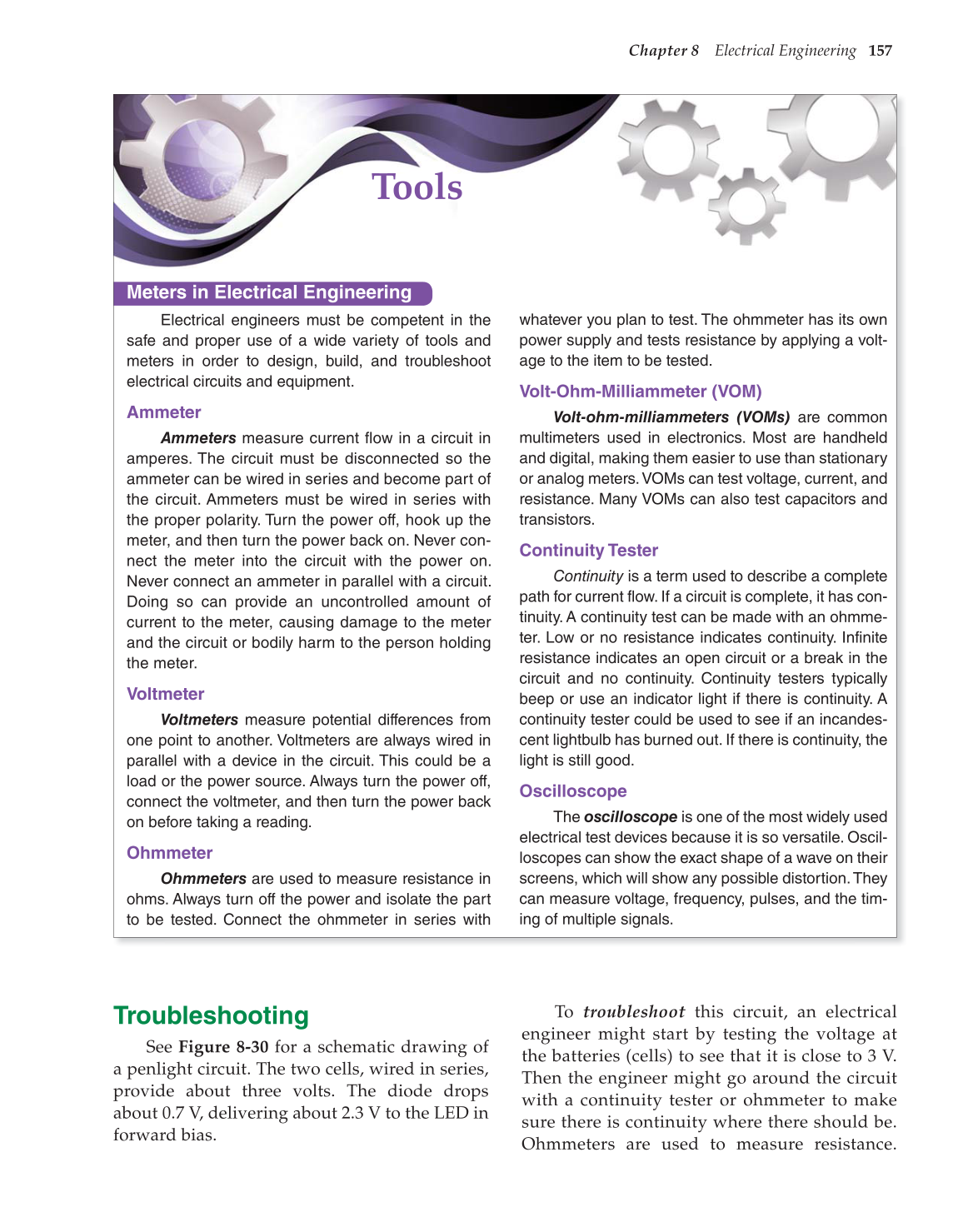Chapter 8 Electrical Engineering 157
Meters in Electrical Engineering
Electrical engineers must be competent in the
safe and proper use of a wide variety of tools and
meters in order to design, build, and troubleshoot
electrical circuits and equipment.
Ammeter
Ammeters measure current flow in a circuit in
amperes. The circuit must be disconnected so the
ammeter can be wired in series and become part of
the circuit. Ammeters must be wired in series with
the proper polarity. Turn the power off, hook up the
meter, and then turn the power back on. Never con-
nect the meter into the circuit with the power on.
Never connect an ammeter in parallel with a circuit.
Doing so can provide an uncontrolled amount of
current to the meter, causing damage to the meter
and the circuit or bodily harm to the person holding
the meter.
Voltmeter
Voltmeters measure potential differences from
one point to another. Voltmeters are always wired in
parallel with a device in the circuit. This could be a
load or the power source. Always turn the power off,
connect the voltmeter, and then turn the power back
on before taking a reading.
Ohmmeter
Ohmmeters are used to measure resistance in
ohms. Always turn off the power and isolate the part
to be tested. Connect the ohmmeter in series with
Tools
whatever you plan to test. The ohmmeter has its own
power supply and tests resistance by applying a volt-
age to the item to be tested.
Volt-Ohm-Milliammeter (VOM)
Volt-ohm-milliammeters (VOMs) are common
multimeters used in electronics. Most are handheld
and digital, making them easier to use than stationary
or analog meters. VOMs can test voltage, current, and
resistance. Many VOMs can also test capacitors and
transistors.
Continuity Tester
Continuity is a term used to describe a complete
path for current flow. If a circuit is complete, it has con-
tinuity. A continuity test can be made with an ohmme-
ter. Low or no resistance indicates continuity. Infinite
resistance indicates an open circuit or a break in the
circuit and no continuity. Continuity testers typically
beep or use an indicator light if there is continuity. A
continuity tester could be used to see if an incandes-
cent lightbulb has burned out. If there is continuity, the
light is still good.
Oscilloscope
The oscilloscope is one of the most widely used
electrical test devices because it is so versatile. Oscil-
loscopes can show the exact shape of a wave on their
screens, which will show any possible distortion. They
can measure voltage, frequency, pulses, and the tim-
ing of multiple signals.
Troubleshooting
See Figure 8-30 for a schematic drawing of
a penlight circuit. The two cells, wired in series,
provide about three volts. The diode drops
about 0.7 V, delivering about 2.3 V to the LED in
forward bias.
To troubleshoot this circuit, an electrical
engineer might start by testing the voltage at
the batteries (cells) to see that it is close to 3 V.
Then the engineer might go around the circuit
with a continuity tester or ohmmeter to make
sure there is continuity where there should be.
Ohmmeters are used to measure resistance.
